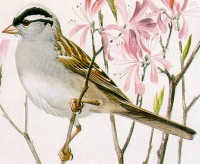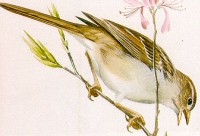
White-crowned Sparrow
Zonotrichia leucophrys (Forster)
Status Uncommon transient, rare in winter. It is very uncommon but regular in spring, generally first appearing in late April or early May (average 6 May, earliest 22 April) and last seen in early June (average 31 May, latest 15 June). Although it is not known to nest, there are two intriguing reports of birds on 22 July 1977 at Wine Harbour, Guysborough County (G. and O. MacLeod), and in early July 1983 near Boularderie, Victoria County (R. Fraser); parts of Guysborough County and Cape Breton Island do have terrain resembling its breeding grounds further north.
Fall migrants normally first appear in late September (average 28 September, earliest 10 September); most are seen in October when, after a strong northwesterly atmospheric flow, large numbers may occur in southern parts of the province—over 400 were present on Seal Island on 23 October 1980. They are generally last seen in November (average 3 November, latest 25 November). However, in recent years they have begun to winter in small numbers. The first to do so stayed at feeders on Sable Island and at Glencoe, Pictou County, in 1968-69. At least 10 have been recorded since on Christmas Bird Counts and another dozen or so have survived the winter at feeders in the southwestern half of the province. "
Description Length: 17-19 cm. Adults: White stripe through centre of crown, bordered by wide black stripes; white stripe on side of head, bordered by black stripe from eye or in front of it; back gray with dark brown stripes; wing with two narrow, white wing bars; underparts gray, belly and throat whiter. Young birds: Similar but with chestnut and buff replacing the black and white on the head.
Range Breeds from northwestern Alaska to central Keewatin and northern Quebec, south to northern Saskatchewan, south-central Quebec and northern Newfoundland, and south in the west to southern California and New Mexico. Winters from British Columbia in the west and Virginia in the east (casually further north) to the Caribbean islands and Mexico.
Remarks This bird is a close relative of the White-throated Sparrow, which it resembles in size and plumage markings. However, the white crown on this bird is larger and more conspicuous than that of the White-throated Sparrow, which has a yellow spot before the eye and a conspicuous white throat, both lacking in the White-crowned Sparrow. Immatures in autumn with their chestnut caps superficially resemble large American Tree Sparrows.
The main migration of this aristocrat of sparrows lies to the west of Nova Scotia, but the bird is regularly reported here, especially when westerlies prevail in fall.
Almost all our birds are of the eastern subspecies, Zonotrichia leucophrys leucophrys. However, a number of individuals of Z. 1. gambelii, which breeds from Hudson Bay to Alaska, have been recorded. Adults of this subspecies can easily be recognized by their yellow, rather than pink, bills and by their black eye stripes which start from the eye, rather than from the base of the bill; the first, on Sable Island from 25 May to early June 1969, was photographically documented by David Higgins. Another spring bird was seen in Dartmouth in late May 1975 and at least eight birds (two confirmed by photographs) have been recorded on Seal Island during autumn since 1972. |


